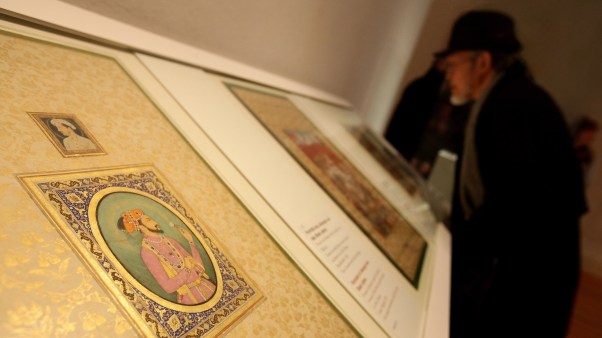My good friend Steve was sipping a second cup of coffee as I walked up to him. I was exhausted after giving my all to the 9 a.m. worship service. Now I needed to find new energy for worship at 10:45.
“Every Sunday morning,” Steve said, “I see you come in here about 10:15, and it’s like you step right through a mirror from one world to another!”
Over the last decade, our congregation has developed two rather distinct worshiping communities. The traditional community meets in the sanctuary. Its design is hushed and spartan, with subtle gray walls, indirect lighting, white cornices and woodwork, and a choir loft directly behind me as I preach. The pews are long and straight, arranged in Puritan concert-hall fashion. The pulpit, with its clean lines, is a dignified symbol of tradition, authority, and austerity. When you enter the sanctuary, you are quiet. The organ sets the mood of somberness.
Worship here is informed by Enlightenment rationality: God is the wholly Other whom you approach at a distance by the mediated steps of classical artistry in word and song.
The contemporary worshiping community, on the other hand, gathers in the sunny Great Room. The chairs are stackables, arranged in a sweeping semicircle of eye-to-eye intimacy. The acoustics in the room are poor, but that doesn’t matter, since the praise team is powered by amplified speakers pointed in every direction. There’s no pulpit, of course—only a music stand, which I may use if I want to. People tell me I preach better if I don’t; I get more “real and personal, not tied to words on a page.”
When you enter the Great Room, it’s noisy. But noisy conversation and people interaction are the home of spirituality in a post-Enlightenment community. God is not “out there”; he is here, among us.
So each week I prepare doubly for Sunday morning worship. Though the message title is the same, my preaching is not immune to the marked distinction between worship services.
The “feel” and “mind” of the two services are so different, yet I’m expected to bring the same message at each service (after all, we are one congregation!).
Shakespeare or “ER”?
Often the very things that make a sermon powerful in the traditional worshiping community decrease its effectiveness at the contemporary worship service. And vice versa.
Sometimes I’m too crafty with my words. The traditional group loves it-they can see God in the art of wordplay. The contemporary group hates it-they think it is trying to put on a show that isn’t real.
I think, for instance, of a message called “Mountain Standard Time,” based on Isaiah 2:1-5, which I prepared for the first Sunday of Advent. Here are a few brief portions of the text:
Somewhere today there’s a man on a business trip away from home. It’s Sunday, and he’s stuck in a distant motel. His only companion is the television. He flicks from channel to channel. And here’s an old movie. He’s seen it before. But it captures his mind again, and he’s caught in a trance—”The Man from Snowy River.” It’s a story of love and courage, of strength and bravery, of gentleness and humility. And long before the final scenes fade into music, he’s crying.
Why? Because something inside his soul just called to him. He’s not sure what it is. Whatever he’s become, whatever it was that brought him to this place on business, it’s not what he wanted his life to be all about. He’s lost something along the way. Because he forgot that Voice. And he followed a different path.
Do you know why you came here this morning? Do you know why you came to this church and wanted to become a member of it? It’s because there’s something of Mountain Standard Time that whistles through this place. We’re bound by the clock out in the lounge that chimes the quarter hour in Eastern Standard Time. But just for a while, in this place of worship, we experience the quickening pace of life on the mountain of God, somewhere beyond the International Date Line. And Mountain Standard Time becomes our wish, and our hope and our prayer.
After I preached this sermon at the traditional worship service, there was a quiet hush, and then people streamed toward me from all directions. This message spoke powerfully to them. They were moved by the theme and the crafting of the words and scenes that conveyed it.
On the other hand, at the contemporary worship service, I felt as if I were just marking time. At appropriate moments people smiled or laughed a little. But mostly they seemed to tell me I was missing the real world. What was I getting at, anyway? A good friend said to me after the service, “Wayne, I sure like your practical sermons better!”
Shakespeare and the classics speak to those in the traditional worshiping community, while hot television programs hit the analogy button in the other.
The similarities
When I preach best for both communities, I do three things well.
First, I exegete faithfully. The Bible is the Word of God, and nothing in my creativity or rhetorical technique can outdo it in power and significance. When I exegete well, I speak for God. Not because I’m such a great speaker, but because he is. He spoke the Word. And he still speaks it today.
Of course, exegeting well doesn’t mean I carry all my exegetical work into the pulpit (or to the music stand) with me. It simply means I have found a message worth preaching because it is God’s message. And it means that the form of the message rings true to the intent of the passage in tone and substance.
Second, I tell stories. Bible stories. Human stories. Literary stories. Early in my preaching ministry, people would at times become polarized by my story-telling, some lauding it and some lashing out at it. A few actually counted the number of stories I told during a message, just to roast the preacher for Sunday dinner.
I find stories are a powerful way to speak across generations and to different audiences. Story-telling helps me bridge the psychological and sociological divide separating my two congregations.
Third, preaching needs to create vision. There must be a larger reality that all enter when they are caught up into the kingdom of God.
I don’t consider Sunday morning preaching to be teaching. Teaching, for me, is the transmission of cognitive information that empowers someone else by its insight. Preaching, while often encompassing a teaching element, is more of an exercise in frame-building and world-portraying.
Our lives get bent out of shape by the plurality of values that set hooks in our hearts from day to day. Preaching rebuilds the frame around our lives so that we stand straight again. I try to call people to participate in a world that is larger than their experiences, one that feeds the craving of their souls, one that always welcomes them at the doorway called HOME.
The differences
Since I keep the two worshiping communities on parallel lines of development through a common calendar of themes and teachings, I cut down my preparation time considerably for Sunday morning. After I have focused my theme, on the basis of exegetical research, I create either a series of “moves” (in the fashion of David Buttrick’s method) or multiple answers to a single question. These become the blocks of my homiletic development.
Over the years I’ve developed a manuscript style that makes it easy for me to read without appearing as if I am closely tied to exact wordings on a page. For the traditional worshiping community, where I am somewhat limited in movement at the pulpit, I basically read the manuscript in an engaging, conversational style.
When I move into the Great Room with the contemporary worshiping community, I usually take the manuscript, though sometimes I jot notes on a slip of paper or even wing it with no notes or manuscript. There I walk back and forth at the center of the crowd, mostly hitting the high points and telling stories. If I have the manuscript, I put it on a music stand and refer to it now and again in order to keep my thoughts focused.
But even the way I tell stories often differs in each setting. Recently, in a message called “Shopping for a New Wardrobe,” based on Paul’s teaching in Colossians 3 to “put off the old self” and to “put on the new,” I began by asking people if they liked what I was wearing. I wanted people to think about the impact clothes make on us when we see others. In my manuscript, which I used rather closely at the traditional worship service, it came out like this:
Do you like what I’m wearing today?
Someone said to me last week that he likes my ties. He said that sometimes, on Sunday mornings, he looks at my ties and wonders where I got them.
I’m not going to tell you!
Most of them I got as gifts, anyway, so I’m not even sure where they came from!
One of my friends who is a pastor says that his people respond to the different colors of the ties he wears on Sunday morning.
Do you think that’s so?!
He says when he wears a yellow tie, they seem to get restless quickly. People are looking at their watches, sitting on the edge of their seats, impatient to be done with this stuff.
My friend says that when he wears a red tie, people seem to sing better. They’re more attentive. They seem to get the point quicker.
Now, I don’t know if he’s on to anything. But I do know that clothes make a statement. We look at each other’s clothes. Teens check out the gear. Does it have the right labels? Is it the kind all the right kids wear at school? Women look at the cut of a dress. Men go for the insignia on the pocket of the shirt.
Ah! Clothes make a point, don’t they?!
I followed through on that point, using the best-selling business book of some years ago, Dressed for Success, to get people thinking about how sometimes, in order to make the right statement, we might have to get rid of our entire old wardrobe and get a brand new one. Of course, this was easy to transition into Paul’s teaching.
When I went to the contemporary worship service, I ad-libbed that entire section. I acted it out, raising my tie in front of the crowd, and walking around for them to inspect it.
In both services the same point was made. However, the telling of the stories was tailored to the particular congregation.
Transition time
As soon as the worship service ends for the traditional worshiping community, I walk out of the front of the church building and move quickly toward my office. This is the part I dislike about making such a quick turnaround on Sunday mornings. I would rather linger with people for a while and spend moments in pastoral conversations.
However, I need to get away in order to make the transition to the next worship service.
Usually I will chat quickly with a few people along the way. I stop for a drink of water to cool my throat. Then, in my office, I take off my suit jacket, role up my shirt sleeves, and sort through the pages of my sermon manuscript. I decide whether I’m going to use the manuscript again, or if I need to make some quick notes on a Post-it note, or if I should try to deliver the message without notes at all. Two-thirds of the time I’ll use the manuscript, at least as a prompt. The other third is divided between notes and no notes.
When I feel a bit at peace with myself, I walk through the church, engaging people in conversation. About ten minutes before the next worship begins, I gather the worship leaders and musicians, and we stand together in a circle, reviewing the process by which that worship service will unfold and the leadership role each person has. Then we pray.
Now I feel like I’ve had time to slow my racing thoughts and refocus my attention on worshiping God. The opening music of the contemporary worship service generally assists in that process. By the time I’m up for the message, I’m ready to go again.
At the best of times, this exercise taxes my powers of communication, draining the energy out of me. At the worst of times, I feel as if I have failed one of the worshiping communities, and I end Sunday with a terrible headache.
Usually I finish Sunday morning somewhere in between. It’s not an ideal situation for either a preacher or a congregation. But it does allow us to broaden our membership base in shared ministries of discipleship and pastoral care. I’m caught on the fence between the groups, sometimes getting splinters from that perch.
Still, when I do my preaching right, there is a great possibility for the divergent congregations at Harderwyk Church to move on parallel paths toward the parousia. And each, on its pilgrimage, can do effective ministry for Christ.
Wayne Brouwer is senior pastor of Harderwyk Christian Reformed Church in Holland, Michigan
1997 by Christianity Today/Leadership Journal.









